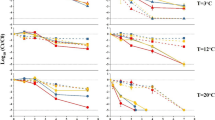Abstract
Bacteria comprise an important part of the aquatic microbial flora and perform myriad of ecological roles in aquatic ecosystems. Yet the bacteriological studies on aquatic ecosystems are scarce, especially in the Himalayan context. The main objective of present study was to assess the bacteriological composition of Manasbal lake, the deepest freshwater lake of Kashmir Himalayas, in relation to anthropogenic pressures. The authors measured abundance of the culturable bacteria in lake waters from March to December 2011 using culture based approaches. A total of 1391 different colonies of the identified bacterial strains were obtained from the lake waters with significant site specific variability. The data indicated that the colony number was highest for site II (surrounded by residential hamlets) followed by site I (an irrigational stream) and III (Central site) and lowest for site IV (Outlet). The strains were identified using the gram’s staining, motility test and biochemical tests. Data revealed a highest percentage occurrence of 14.67 % for Proteus II and lowest of 0.21 % for Shigella I. This study indicated the need for development of a feasible system with regular assessment of microbial population for ascertaining the proper microbial load in order to effectively combat the multiple dangers of anthropogenic pollution of the lake.


Similar content being viewed by others
References
Atlas RM, Bartha R (1993) Microbial ecology: fundamentals and applications, 3rd edn. Benjamin, Redwood City
Zwart G, Crump BC, Kamst-van AMP, Hagen F, Han SK (2002) Typical freshwater bacteria: an analysis of available 16S rRNA gene sequences from plankton of lakes and rivers. AquatMicrobEcol 28:141–155
Bouwman LA, Bloem J, Van den Boogert PHJF, Bremer F, Hoenderboom GHJ, De-Ruiter PC (1994) Short-term and long-term effects of bacterivorous nematodes and nematophagous fungi on carbon and nitrogen mineralization in microcosms. Biol Fertil Soils 17:249–256
Bloem J, LA De-RuiterPC Bouwman (1997) Food webs and nutrient cycling in agro-ecosystems. In: Van Elsas JD, Trevors JT, Wellington E (eds) Modern soil microbiology. Marcel Dekker, New York, pp 245–278
Muylaert K, Vander GK, Vloemans N, Meester LD, Gillis M, Vyverman W (2002) Relationship between bacterial community composition and bottom-up versus top-down variables in four eutrophic shallow lakes. Appl Environ Microbiol 68:4740–4750
Griffths RC, Whitely AS, Donmell AG, Bailay MJ (2003) Influence of depth and sampling time on bacteria (community in a upland grassland soil). FEMS Microbiol Ecol 43:35–43
Parson A, Jefferson B (2006) Introduction to potable water treatment processes. Blackwell publication, Malden
Khulbe RD, Sati MC, Dhyani AD (1988) In: Khulbe RD (ed) Prespectives in aquatic biology. Papyrus Publication, New Delhi, pp 269–279
James EJ (2005). Management of river basins in relation to coastal wetlands: case studies from Indian subcontinent. In: Proceeding of Kerala Environment Congress, pp 21–47
Lawrence WT (1895) The valley of Kashmir. Asian Educational Services, London, pp 40–42
Raina AN (1971) Geography of Jammu and Kashmir. RadhaKrishanAnand & Co., Jammu
Yousuf AR (1992). Biotic Communities and their role in the tropic conditions in Kashmir Himalayan Lakes, Technical Report submitted by the University of Kashmir, CSIR Research Project
Zutshi DP, Vass K (1978) Limnological studies on Dal Lake-chemical features. Indian J Ecol 5:90–97
APHA (1998) Standard methods for the examination for water and waste water, 4th edn. American Public Health Association, New York
Clesceri LS, Greenberg AE, Eaton AD (1998) standard methods for examination of water and wastewater. APHA, Washington D.C, p 140
Sharp, Lyles ST (1969) Laboratory instruction in biology of microorganisms. Saint Louis the C V Mosley Company, St. Louis, pp 23–25
Holt JG, Krieg NR, Sneath PHA, Staley JT, Williams ST (1994) Bergey’s manual of determinative bacteriology, 9th edn. Williams and Wilkins, Baltimore, pp 175–222
Temesgen Z, Toal DR, Cockerill FR (1997) Leclerciaadecarboxylata infections: case report and review. Clin Infect Dis 25:79–81
Stock I, Sherwood KJ, Wiedemann B (2004) Antimicrobial susceptibility patterns, [beta]-lactamases, and biochemical identification of Yokenella regensburgei strains. Diag Microbiol Infect Dis 48:5–15
Geldreich EE (1972) Buffalo lake recreational water quality: a study in bacteriological data interpretation. Water Res 6:913–924
Matsen MJ, Blazevic DJ, Ryan JA, Ewing WH (1972) Characterization of indole-positive Proteus mirabilis. Appl Microbiol 3(23):592–594
Sharma P, Sood A, Sharma S, Bisht S, Kumar V, Pandey P, Gusain MP, Gusain OP (2010) Bacterial indicators of faecal pollution and physiochemical assessment of important North Indian lakes. RMZ—Mater Geo-environ 57(1):25–40
Radha S, Seenayya G (2004) Ecological aspects of highly polluted and eutrophicated Husainsagar Lake sediments and its impact on mineralization of organic matter. Asian J Microbiol Biotechnol Environ Sci 6:367–371
Sood A, Singh KD, Pandey P, Sharma S (2008) Assessment of bacterial indicators and physico-chemical parameters to investigate pollution status of Gangetic river system of Uttarakhand (India). Ecol Indic 8:709–717
Lokoska L, JordanoskiM, Veljanoska-Sarafiloska E (2004). The water quality of the Lake Prespa and its tributaries. In: Simposium of ecologists of the republic of Montenegro, Tivat
Christina SPW, Mullarky IK,Currin J (2011).Klebsiella spp.: a practical summary for controlling mastitis. College of Agriculture and Life Sciences, Virginia Polytechnic Institute and State University pp 1–2
Nazarowec WM, Farber JM (1999) Phenotypic and genotypic typing of food and clinical isolates of Enterobacter sakazakii. J Med Microbiol 48:559–567
Kaper JB, Morris JG, Levine MM (1995) Cholera. Clin Microbiol Rev 8:48–86
WHO (2002) Vibrio cholerae. In: Guidelines for drinking-water quality, 2nd ed. Addendum: Microbiological agents in drinking water. World Health Organization, Geneva, pp 119–142
Acknowledgments
The authors are thankful to the Centre of Research for Development and Department of Environmental Sciences, University of Kashmir for providing the necessary laboratory facilities to carry out this work.
Author information
Authors and Affiliations
Corresponding author
Rights and permissions
About this article
Cite this article
Shafi, S., Kamili, A.N., Shah, M.A. et al. Isolation, Identification and Distribution of Culturable Bacteria in Manasbal Lake, Kashmir Himalaya. Proc. Natl. Acad. Sci., India, Sect. B Biol. Sci. 87, 115–120 (2017). https://doi.org/10.1007/s40011-015-0582-1
Received:
Revised:
Accepted:
Published:
Issue Date:
DOI: https://doi.org/10.1007/s40011-015-0582-1




